 |
 |
 |
| | Home | People behind the Scenes | Koichi Takatsu | Part 3, In the Workshop |
| |
|
|

![]() Part 1, Learning the Craft
Part 1, Learning the Craft
![]() Part 2, Feelings About Noh Masks
Part 2, Feelings About Noh Masks
![]() Part 3, In the Workshop
Part 3, In the Workshop
Part 3, In the Workshop
Mr. Takatsu showed us the mask making process in his workshop.
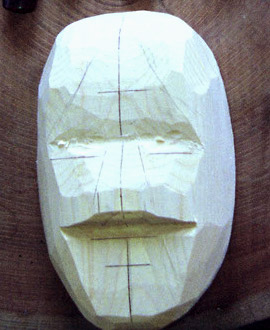 |
Photo: Toshiro Morita |
Mask making materials
Using stable material, Hinoki with few knots, boards with measurements of 7x5 sun (thickness of 2 sun 5 bun, 3 sun) are cut. (1 sun is around 3cm. Nowadays there are materials are often sold in 22x15x7.5cm sizes.)
Takatsu’s comments: Shortening a Noh mask by just 5mm can really reduce the expression. Hinoki is a stable material that doesn’t warp easily, and as it becomes resistant when treated with resin, it is perfect for Noh masks. The presence of resin means that wrinkles can later develop, and sometimes oil must be removed. However, the wrinkles that develop as a result of the resin are extremely delicate, and show the age of the mask, and it is interesting as they are what can make a famous mask. Among Hinoki, Bishū Hinoki is the finest material.
The process of creating a Noh mask
There are basically two parts of the process, carving and coloring, and among these are creating the wooden base of the mask, applying lacquer to the underside, and removing oil.
Carving
Takatsu’s comments: Noh masks have a shape that has been passed down for hundreds of years and set measurements. Based on that, the silhouette of the Noh mask is drawn on the material. Then, the mask is carved, and the actual style of carving depends on the individual. The Noh mask master uses their own styles that suit them. Some people begin with just one side, while others remove what they don’t need at the end. It is difficult to describe the process in words.
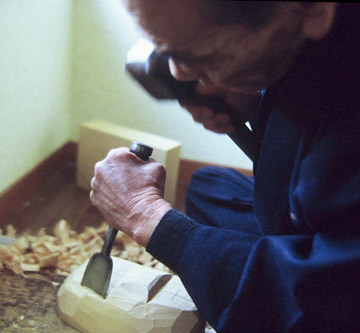 |
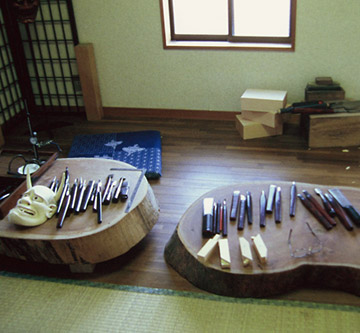 |
Takatsu making an Ōmi-Onna mask. He begins by removing the unneeded portion. Our eyes glued to the smooth motion of his hands.
Photo: Toshiro Morita |
Carving workshop with a silent and tense atmosphere.
Photo: Toshiro Morita |
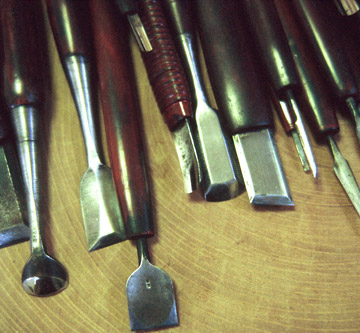 |
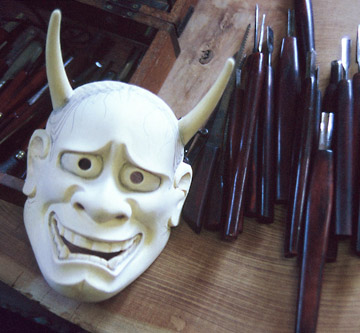 |
An amazing number of chisels. “I began to collect ones that were easy to use, and this is what I ended up with.” (Takatsu)
Photo: Toshiro Morita |
A finished Hannya mask. The corners are fixed later. Photo: Toshiro Morita |
Coloration
Takatsu’s comments: The coloring process takes lots of time. Painting and drying, repeating that process many times until applying the middle and top layer of pigment. Applying numerous layers of paint gives depth to the expression of the mask. The color is adjusted delicately depending on the mask. The feeling of the mask changes based on those subtle adjustments. depending on the style of play, a deep white or a red might be desirable.
Especially, the final task of applying ink to the eye area with a brush requires much concentration. If you fail you have to fix everything from the bottom layer.
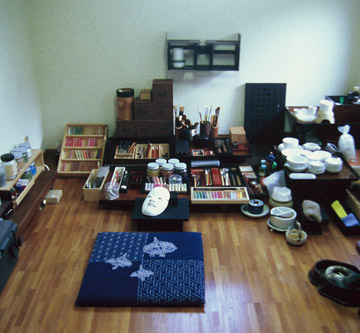 |
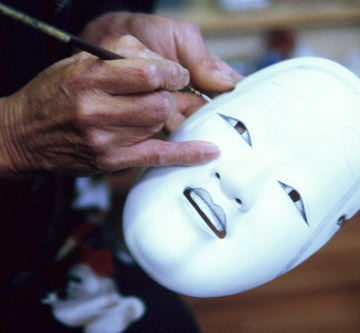 |
Pigments arranged neatly by color in the workroom.
Photo: Toshiro Morita |
Draw at a one stroke using his pinky as a supporting point and ruler. Marvelous technique! Photo: Toshiro Morita |
(Interview: January, 2011)
Profile : Koichi Takatsu
Koichi Takatsu, a Noh mask master, was born in 1941 in Hiratsuka, Kanagawa. In 1964 he dedicated himself to becoming a Noh mask master, and began studying mainly in Kyoto. In 1987, “A Special Exhibit of Koichi Takatsu Noh Masks” was held in Odawarajo (hosted by Odawara City). Since 1991, Takatsu has worked as a researcher at Tanba-Sasayama Noh Museum, studying and restoring old masks. In 2008, his work appeared in the “Modern Noh and Kyōgen Author” exhibit at the Waseda University Museum of Theater, and in 2010 at the “Koichi Takatsu, Michihiko Ito and Hisato Iwasaki Exhibit of Modern Noh and Kyōgen Masks” held by the Tamagawa University Museum of Education. In November of 2010, Takatsu held co-exhibition with Donato Sartori, Italian Mask Maker in Padova, Italy, sponsored by University of Venice, University of Padova and so on. In 1994 Takatsu was awarded a prize for his support of culture from the Rotary Club, and in 2003 he was awarded by the Association of Shinto Shrines. His books include The Pigments of Noh Masks (Tamagawa University Press), Making Noh Masks (Tamagawa University Press) and The Style of Noh Masks (Toho Shuppan).
| Terms of Use | Contact Us | Link to us |
Copyright©
2026
the-NOH.com All right reserved.